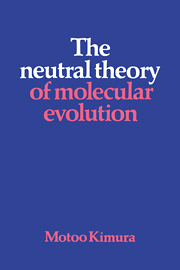
The Neutral Theory of Molecular Evolution
Encyclopedia

Monograph
A monograph is a work of writing upon a single subject, usually by a single author.It is often a scholarly essay or learned treatise, and may be released in the manner of a book or journal article. It is by definition a single document that forms a complete text in itself...
written in 1983 by Japanese
Japanese people
The are an ethnic group originating in the Japanese archipelago and are the predominant ethnic group of Japan. Worldwide, approximately 130 million people are of Japanese descent; of these, approximately 127 million are residents of Japan. People of Japanese ancestry who live in other countries...
evolutionary biologist Motoo Kimura
Motoo Kimura
was a Japanese biologist best known for introducing the neutral theory of molecular evolution in 1968. He became one of the most influential theoretical population geneticists. He is remembered in genetics for his innovative use of diffusion equations to calculate the probability of fixation of...
. While the neutral theory of molecular evolution
Neutral theory of molecular evolution
The neutral theory of molecular evolution states that the vast majority of evolutionary changes at the molecular level are caused by random drift of selectively neutral mutants . The theory was introduced by Motoo Kimura in the late 1960s and early 1970s...
existed since his article in 1968, Kimura felt the need to write a monograph with up-to-date information and evidences showing the importance of his theory in evolution
Evolution
Evolution is any change across successive generations in the heritable characteristics of biological populations. Evolutionary processes give rise to diversity at every level of biological organisation, including species, individual organisms and molecules such as DNA and proteins.Life on Earth...
.
Content
- From Lamarck to population genetics
- Overdevelopment of the synthetic theory and the proposal of the neutral theory
- The neutral mutation-random drift hypothesis as an evolutionary paradigm
- Molecular evolutionary rates contrasted with phenotypic evolutionary rates
- Some features of molecular evolution
- Definition, types and action of natural selection
- Molecular structure, selective constraint and the rate of evolution
- Population genetics at the molecular level
- Summary and conclusion

